Analysis of Three Most Common Performances of Protective Gloves
Author:Gloves Addtime:2024-01-03 16:13:10 Click:
Protective gloves are an indispensable part of personal protective equipment, serving to safeguard hands from various workplace hazards. Understanding the key performances of these gloves is essential for making informed choices based on the specific requirements of different tasks. Here, we analyze three of the most common performances of protective gloves:
1. Cut Resistance:
One of the critical performances of
protective gloves is cut resistance. Industries such as construction, metalworking, and handling sharp objects necessitate gloves that can withstand cuts and slashes. Gloves with cut-resistant materials, such as Kevlar or high-performance polyethylene, provide an effective barrier against sharp edges and blades.
2. Chemical Resistance:
Chemical resistance is crucial for gloves used in environments where exposure to hazardous substances is a concern. Gloves with chemical-resistant properties shield the skin from corrosive chemicals, acids, and solvents. Materials like nitrile, neoprene, and butyl rubber are commonly used for their resistance to a wide range of chemicals.
3. Abrasion Resistance:
Abrasion resistance is vital for gloves that will be subjected to rough surfaces and materials. In industries like construction, manufacturing, and automotive, gloves with strong abrasion resistance help withstand friction and extend their lifespan. Coatings such as latex or polyurethane can enhance the durability of gloves in abrasive conditions.
Key Considerations:
When selecting protective gloves, it's crucial to consider the specific requirements of the task at hand. A thorough risk assessment should identify potential hazards, guiding the choice of gloves with the appropriate level of protection. Understanding performance ratings and standards, such as ANSI/ISEA standards for cut resistance, aids in making informed decisions.
Maintenance and Replacement:
Regular maintenance and timely replacement of protective gloves are essential to ensure their continued effectiveness. Inspect gloves for signs of wear, tear, or degradation after each use. Damaged gloves should be replaced promptly to maintain their protective qualities and prevent potential injuries.
Training and Education:
Proper training and education on the use of protective gloves contribute significantly to their effective implementation. Workers should be educated on the specific features and limitations of the gloves they use, as well as the importance of adhering to safety protocols.
In conclusion, the analysis of cut resistance, chemical resistance, and abrasion resistance provides a foundation for understanding the essential performances of protective gloves. By selecting gloves tailored to the specific needs of a task and ensuring proper maintenance, users can confidently rely on these crucial tools to mitigate workplace risks and enhance overall safety.
